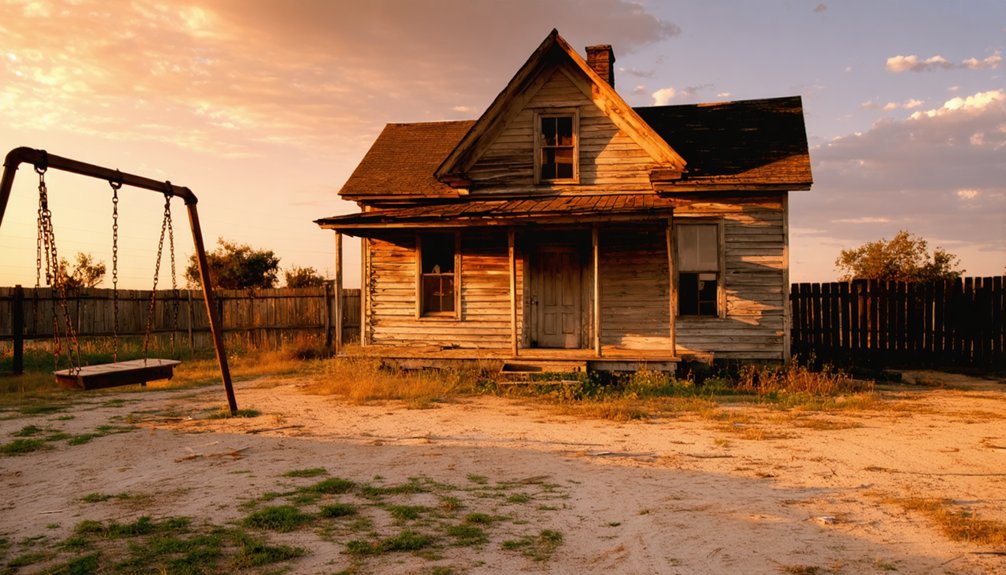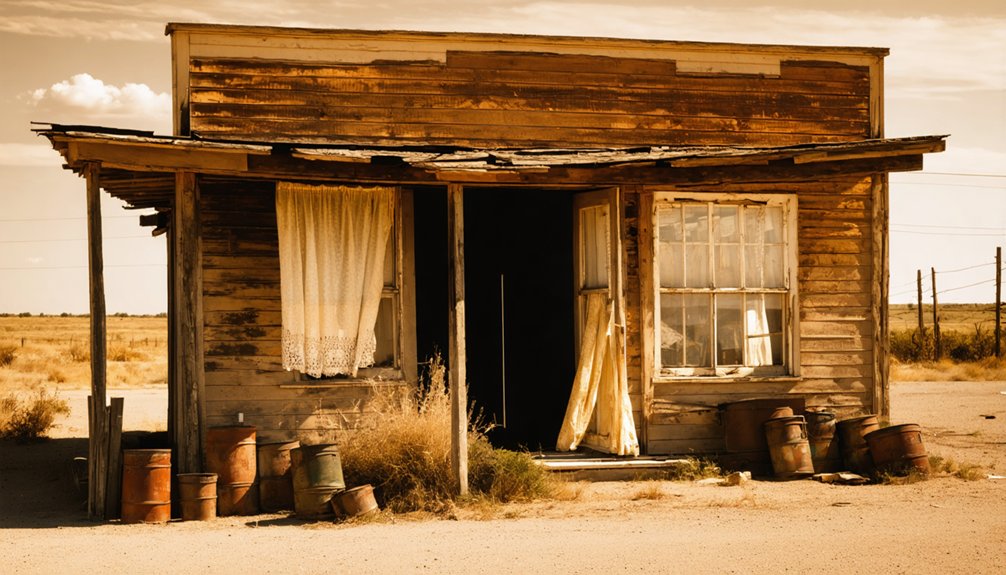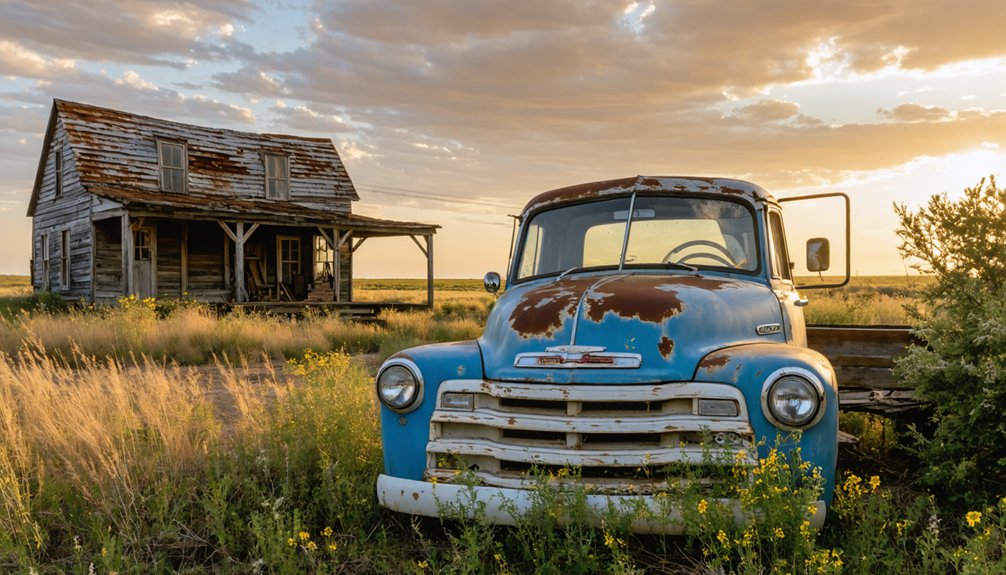You’ll find Who’d Thought It nestled in northern Hopkins County, Texas, where its peculiar name remains a mystery. This ghost town emerged after 1900, built on cotton and corn farming. It once boasted a thriving school, church, and cemetery through the 1930s, serving as a hub for rural families. By the 1960s, the community declined when its school merged with a larger district. The town’s enigmatic story mirrors countless lost Texas settlements waiting to be discovered.
Key Takeaways
- Who’d Thought It was established after 1900 in northern Hopkins County, Texas, with an unusual name lacking documented explanation.
- The community centered around cotton and corn farming, with most farmers working approximately 150-acre plots supported by local businesses.
- A one-room schoolhouse served 34 children by 1903, functioning as both an educational facility and community gathering space.
- The settlement included a church and cemetery in the 1930s but declined after its school merged with a larger district in the 1960s.
- Who’d Thought It followed a common pattern of Texas ghost towns, experiencing population loss as younger generations moved to urban areas.
The Peculiar Tale Behind the Name
While many Texas ghost towns derive their names from settlers or geographic features, the origin of “Who’d Thought It” remains one of the state’s most intriguing naming mysteries.
Unlike neighboring communities with clear naming histories, you won’t find any documented explanation for this peculiar ghost town’s moniker in historical records or official sources.
The peculiar name “Who’d Thought It” remains a historical mystery, with no official records revealing its puzzling origins.
Name speculation suggests the phrase might reflect settlers’ surprise at the community’s establishment or survival, but without concrete evidence, this remains conjecture.
What you do know is that this small farming settlement, established after 1900 in northern Hopkins County, stood out from typical naming conventions of the era.
Some Texas towns like Tinrag reversed Garnit to create their names, showing a pattern of backward spellings across the state.
While other Texas towns often reversed family names or honored founders, “Who’d Thought It” defies such straightforward explanations, preserving its enigmatic character.
Just like the nearby town of Dillon which disappeared from maps by the 1930s, this settlement became one of many ghost town casualties in rural Texas.
Life in Early Rural Hopkins County
As pioneers ventured into Hopkins County during the late 1830s, they encountered a frontier landscape previously inhabited by Caddo and Cherokee tribes.
You’d have found these early settlers, like the Gregg family who established the first permanent home in Sulphur Bluff in 1837, facing pioneer hardships while carving out their existence through subsistence farming and small-scale commerce.
The terrain provided natural advantages for farming with level to rolling elevations perfect for agriculture.
Despite rural isolation, families maintained connections through community events and news sharing. Most newcomers arrived from other parts of Texas or southern states, including the Hopkins family who made their way from Clarksville in the winter of 1843.
You would’ve witnessed a growing population reaching 2,623 by 1850, with settlers adapting to frontier life through tightly knit communities and shared agricultural practices. The county’s early development was shaped by the need to collect taxes from landowners to support local governance and infrastructure.
Agricultural Roots and Local Commerce
You’ll find that cotton and corn dominated the agricultural landscape of early Hopkins County, with individual farmers working plots typically around 150 acres.
The town’s commercial district supported these agricultural endeavors through essential businesses like cotton gins, general stores, and warehouses where farmers could process and trade their harvests.
Local merchants and traders established a vibrant commercial hub around these agricultural operations, providing both economic opportunities and community gathering spaces for the rural population. Similar to the town of Carlton, the area experienced significant growth through cotton production success, attracting new residents and businesses. However, like many rural Texas communities, the town faced declining populations as younger generations moved to larger urban centers along Interstate 35.
Cotton and Corn Production
The agricultural foundation of many Texas ghost towns rested heavily on two key crops: cotton and corn. You’ll find that Spanish missionaries first planted cotton varieties in Texas around 1745, while Anglo-American settlers expanded production dramatically after 1821. By 1859, Texas was producing over 431,000 cotton bales annually, transforming local economies and social structures.
Many farmers relied on the crop-lien system to finance their operations, often leaving them trapped in a cycle of debt to landowners. You’d see farmers implementing corn techniques alongside their cotton operations, especially in sandy soils. While cotton served as the primary cash crop, corn provided essential sustenance for families and livestock. In Audubon, settlers utilized the area’s waist-high native grasses for grazing livestock between crop plantings.
This dual-crop system thrived until the devastating boll weevil invasion of 1888 forced many farmers to abandon cotton. When railroads bypassed certain communities and cotton production declined, towns that couldn’t adapt often faded into ghost towns, leaving behind remnants of their agricultural heritage.
Local Stores and Trade
Supporting these agricultural communities, local stores and trading posts formed the commercial backbone of early Texas towns. You’d find general stores stocked with everything from basic food staples to essential farming tools, serving as crucial hubs of general commerce for the surrounding areas.
These establishments weren’t just retail outlets – they were the lifeblood of local trading practices. Store owners often extended credit to farmers and ranchers, understanding the seasonal nature of agricultural income. The Hicks-Cobb general store in Medicine Mound exemplified this vital role in the community.
You could witness the ebb and flow of commerce following harvest cycles, with cotton gins and livestock sales driving economic activity. Local merchants acted as middlemen, collecting agricultural surplus and connecting producers to broader markets through stagecoach lines and railway depots. Like many of the 511 ghost towns across Texas, these commercial centers began their slow decline when transportation routes shifted or natural resources depleted.
When transportation routes shifted or natural resources depleted, these commercial centers began their slow decline into ghost town status.
Community Landmarks and Daily Life
While exploring Texas ghost towns today, you’ll encounter fascinating remnants of once-thriving communities, from stone courthouses and jails to mining facilities that tell stories of bustling 19th and early 20th-century life.
You’ll find ghost town landmarks like the Terlingua mining structures and Helena’s museum, where artifacts preserve the area’s rich history. Throughout these abandoned places, you’ll discover open spaces once used for horseshoes and ax throwing, with informational placards detailing the towns’ significance.
Daily life centered around mining, particularly in boomtowns where residents worked quicksilver mines. Local grocery stores served both townspeople and notorious visitors like Bonnie and Clyde.
Life in these boomtowns revolved around quicksilver mining, with local stores serving everyone from miners to infamous outlaws.
Community gatherings, including chili cook-offs, brought people together – a tradition that continues in places like Terlingua, where annual events still draw crowds to this day.
Education and Social Connections

You’ll find that Sand Hill’s educational life centered around its one-room schoolhouse, where students of all ages gathered to learn reading, writing, and arithmetic.
The school building served double duty as a community center, hosting town meetings, social gatherings, and holiday celebrations that brought families together.
Parents would often contribute to school activities by providing supplies, maintaining the grounds, and organizing events that strengthened the bonds between neighbors.
Schooling at Sand Hill
After 1900, Sand Hill established its local school, which became an essential educational and social cornerstone for the rural community.
You’ll find that by 1903, the White common school district served 34 children, and the school’s influence expanded to include students from nearby Who’d Thought It. The school history reflects a typical one- or two-room schoolhouse setup, where limited resources didn’t prevent dedicated community education efforts.
During the 1930s, you’d have seen the school thriving alongside a church, cemetery, and scattered houses, serving as a crucial hub for social connections among rural families.
The school’s role extended beyond academics, strengthening bonds between dispersed households until its eventual merger with a larger district by the 1960s, which marked the beginning of the community’s decline.
Community Gatherings and Events
Despite its ghost town status, Sand Hill maintains a vibrant community spirit through various social gatherings and cultural events.
You’ll find historical preservation efforts at the heart of these gatherings, from the annual Victorian Tea Party in April to the Indian Heritage Summer Festival each October. Community engagement thrives through heritage tours, reenactments, and traditional craft demonstrations that keep cultural memory alive.
When you visit during festival season, you’ll experience collaborative events between local Indigenous groups and historical societies, offering educational workshops and storytelling sessions.
These gatherings serve multiple purposes – they foster social connections, support the local economy through tourism, and help maintain historic buildings. The events also provide essential funding for the Karnes County Historical Society Museum’s preservation projects through community-driven fundraising efforts.
The Path to Abandonment
While many Texas ghost towns share common abandonment patterns, their paths to desertion typically begin with economic decline.
You’ll find that when key industries like mines or hospitals shut down, it triggers a devastating chain reaction. Economic factors drive mass exodus as residents seek opportunities elsewhere, particularly along the Interstate 35 corridor.
Migration patterns show that 75 Texas counties have lost population since 2022, with the High Plains region hit hardest.
You’re witnessing a perfect storm: businesses close, tax bases shrink, and infrastructure crumbles. Without diversified economies, these towns can’t survive when their primary industry fails.
Natural disasters, resource depletion, and harsh environmental conditions further accelerate abandonment.
Sometimes it’s sudden, but more often you’ll see a slow fade – decades of gradual decline until only empty buildings remain.
Legacy of a Lost Settlement

The legacy of Texas ghost towns lives on through their compelling historical narratives and physical remnants. You’ll discover this cultural significance in places like Terlingua, where mercury mining ruins tell stories of industrial ambition, and Indianola, where port city remains chronicle nature’s devastating impact on human settlement.
Each ghost town preserves unique chapters of Texas history. You can explore Thurber’s pioneering electric infrastructure that once powered one of America’s first company towns, or walk through Toyah’s preserved buildings that capture the essence of 1880s trading posts.
In Helena, you’ll find tales of the infamous “Helena duel” still echoing through partially inhabited streets. These settlements’ architectural remains, from general stores to mining facilities, serve as time capsules, revealing how economic forces, natural disasters, and technological changes shaped Texas’s development.
Frequently Asked Questions
Was the Community Ever Connected to Nearby Native American Settlements or Trading Routes?
You’ll find the area was greatly connected to Native American influence through Comanche and Apache trading routes, with the town’s location intersecting Indigenous pathways used for commerce and migration.
Did Any Notable Outlaws or Historical Figures Pass Through Who’d Thought It?
Quiet as a church mouse, you won’t find any outlaw legends or historical significance here – there’s no documented evidence of notable outlaws or historical figures ever passing through this small farming settlement.
What Natural Disasters or Epidemics Affected the Town’s Development?
You won’t find clear records of specific hurricane impacts or epidemic outbreaks in Who’d Thought It, though Southeast Texas towns commonly faced these challenges during the late 1800s settlement period.
Were There Any Churches or Cemeteries Established in the Community?
You won’t find documented church history or burial practices for this location, as historical records don’t clearly indicate whether any churches or cemeteries were established in this small community.
What Crops Were Primarily Grown by Farmers in Who’d Thought It?
You’ll find farmers primarily grew wheat and corn as staples, while engaging in cotton production for cash income. They practiced crop rotation and grew hay to support their livestock needs.
References
- https://frontporchnewstexas.com/2022/10/31/history-of-whod-thought-it-texas-ghost-town/
- https://frontporchnewstexas.com/2022/10/31/history-of-dillon-texas-ghost-town/
- https://www.youtube.com/watch?v=phjUE19A8HM
- https://www.texasalmanac.com/places/whod-thought-it-0
- https://www.ntxe-news.com/artman/publish/article_80009.shtml
- https://www.texasescapes.com/TexasGhostTowns/WhodThoughtItTexas.htm
- https://kicks105.com/ghost-town-strange-name/
- https://discovertexasoutdoors.com/places/whod-thought-it/
- https://frontporchnewstexas.com/2022/10/31/history-of-tinrag-texas-ghost-town/
- https://www.tshaonline.org/handbook/entries/whod-thought-it-tx



